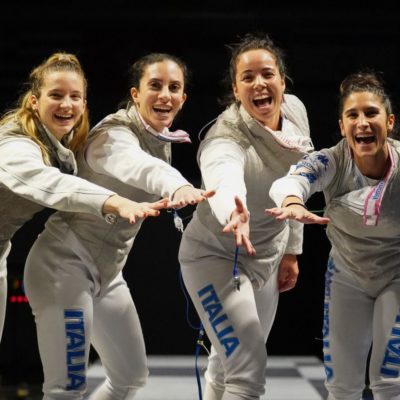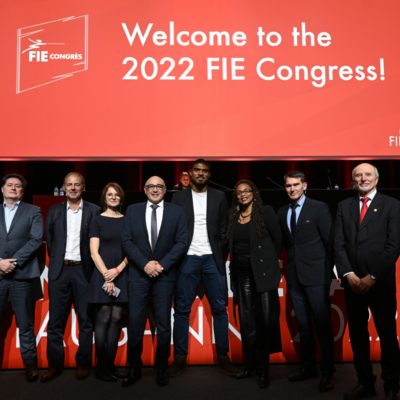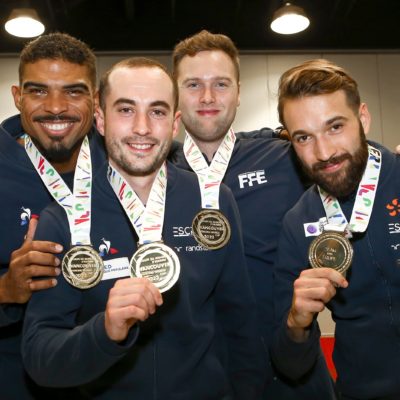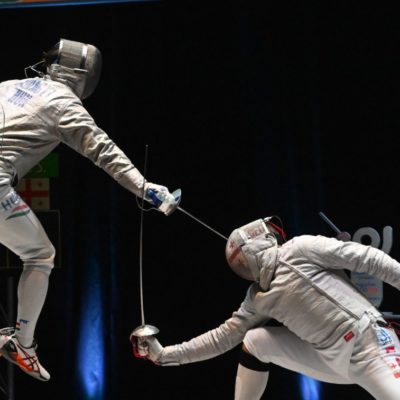Serge Timacheff speaks with the Jose Eduardo dos Santos, president of the SEMI commission in the FIE.
Learn more about the reeless ("wireless") fencing system used in sabre and how it will be moved to foil and epee in the near future.
Click here to download the interview in mp3 format.
Transcript:
interviewer: So, we’re speaking with Eduardo dos Santos of the FIE, who is responsible for, he’s a, what is your title with the FIE?
Jose Eduardo
dos Santos: I am the President of the Materials and Inspection Commission named SEMI.
Interviewer: And so, he’s been responsible for much of the development and implementation of the wireless systems, and at many of the Grand Prix’s now they’ve been doing, then at the Junior World Championships we used wireless systems both, not only for saber and also for epee and foil. So can you tell us a little bit about what the current state of wireless technology is in use in FIE competition?
Jose Eduardo
dos Santos: We just, everyone approved the equipment since the equipment must function without any faults and this is from an Ukrainian company named StM. And the system works well but is not yet what we want to achieve but is this type of the art. In the future we want a simpler system with less portable [components] because the current system it has one around the body and the other in the, near the head. And we are already developing efforts with other companies. Not just for them to make a better development and research but to make the current one, StM also to make their own research and tried to upgrade their system. So this is, the current system is probably what will be used in the Olympics 90 percent of the chances or more, and it works well for the weapons. So we hope to have at least one more weapon than saber using the wireless in the Olympics.
Interviewer: What are the biggest problems you’ve had with epee and foil since they’re the newest ones to use the wireless technology?
Jose Eduardo
dos Santos: The biggest problem for foil was to be able to make these with the white lamp because the circuit is much simpler without white lamp and, as you know, in foil there is a white lamp for seeing the touches in the non-valid zone.
Interviewer: Off-target.
Jose Eduardo
dos Santos: Off-target. And so this was the major problem. It was to create the wireless with the white lamp. But we achieved this even in 2005 in Leipzig and then it was just to put the system in a point that we could use it in the FIE competitions as it is being using now.
Interviewer: I understand that there were some concerns about invalid scoring of double-touches in epee?
Jose Eduardo
dos Santos: What do you mean by invalid?
Interviewer: That the wireless system was not showing double-touches correctly in epee.
Jose Eduardo
dos Santos: No, it is now. I don’t know – When there is a new technology always there is what we call the use problem because it stopped being used and we have to discover all of the things that is improved. So it’s normal to have one or other touches in a new technology this is not signaling corrected but since we have improved the system this is not affecting us anymore.
Interviewer: So for the World Championships this year in St. Petersburg, are we expecting to use all wireless systems and from what level of competition on?
Jose Eduardo
dos Santos: Supposedly from the 32 because we have to have a number of devices to place on the fencers to be able for them to do the wireless. I think that minimum foil it will be also wireless. And epee, we will see. It depends on the, how much it will be used on the other competitions because the fencers aren’t also, also don’t like to play with new systems.
Interviewer: How expensive is a typical wireless system?
Jose Eduardo
dos Santos: It will be the price of the other apparatus. What we have now is that the wireless system supports himself on the existent equipment and why. So, you are playing wireless and you have your wireless box signaling and the normal apparatus is being used as a repeater for the lamps and the signaling. And in case something goes wrong you can take all the wireless system from the fencer and continue the match in the point as it is with the normal system. That’s why we have these things. So is an add-on to the cost of the exiting system, mostly costs the same as the other one. The one of the problems is to operate this you need technicians and to make them come to the competitions wherever they are and support their say and not just the feels to work, and this is also the same problem we have with the video refereeing and so on. But then again to produce a good competition with wireless and video refereeing and so on, you need all this so you have extra parts.
Interviewer: And explain briefly how it’s set up on each fencer. What do they have to have on them and why?
Jose Eduardo
dos Santos: We developed the system in a way that the fencer comes with his normal equipment and a box is plugged into their body cord and the transmission is via portable which usually it does around 200 grams and is placed on the the fencer, on the mask.
Interviewer: On the tang?
Jose Eduardo
dos Santos: On the tang of the mask. And so from the fencer’s point of view, it doesn’t change anything except having some, with more pieces of equipment on them but also he has not anymore the reel pushing him back and forth.
Interviewer: Do any fencers seem to have any problem with the device on the back of their tang on the mask?
Jose Eduardo
dos Santos: No, just on the beginning, when they were not used they were complaining because it’s a little extra weight because the portable has a battery and so is not of zero grams of course but it is never more than 200 grams anyhow. So in the beginning they were not feeling comfortable but now that they are adapting they feel comfortable.
Interviewer: Do most fencers find that they like fencing without wires?
Jose Eduardo
dos Santos: Yes, they feel free and it’s good also for photos and image since you don’t have anymore of these like wires bouncing and the sound of the wire beating on the strip because the strip is in metal and this is annoying to have this bump, bump, bump, bump, bump from the wire beating.
Interviewer: And where do you see the development of wireless technology going between now and by the Olympics and beyond? What developments do you expect to see that will change it or make it different?
Jose Eduardo
dos Santos: Presently the communication is mostly in Bluetooth and there are other technologies like optical and infrareds and so on. So these new ways of communicating, they are appearing and for the portable on the fencer to communicator to the apparatus and this will permit to have this new technologies applied to the wireless fencing and probably this is now but it will be the future or the evolution also.
Interviewer: Okay. That’s good.
[End of Audio]





